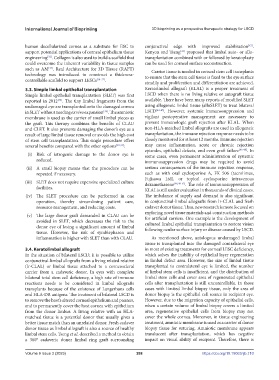Page 296 - IJB-9-3
P. 296
International Journal of Bioprinting 3D bioprinting as a prospective therapeutic strategy for LSCD
human decellularized cornea as a substrate for ESC to conjunctival edge with improved stabilization .
[42]
support potential applications of corneal epithelium tissue Kenyon and Tseng proposed that limbal auto- or allo-
[23]
engineering . Collagen is also used to build a scaffold that transplantation combined with or followed by keratoplasty
[32]
could overcome the inherent variability in tissue samples can be used for corneal surface reconstruction.
such as AM . Real Architecture for 3D Tissue (RAFT) Carrier tissue is needed in corneal stem cell transplants
[33]
technology was introduced to construct a thickness- to ensure that the stem cell tissue is fixed to the eye surface
controllable scaffold to support LESCs [34-37] . steadily and proliferation and differentiation are achieved.
3.3. Simple limbal epithelial transplantation Keratolimbal allograft (KLAL) is a proper treatment of
Simple limbal epithelial transplantation (SLET) was first LSCD when there is no living relative or autograft tissue
reported in 2012 . The tiny limbal fragments from the available. There have been many reports of modified SLET
[38]
undamaged eye are transplanted onto the damaged cornea using allogeneic limbal tissue (alloSLET) to treat bilateral
in SLET without needing ex vivo expansion . The amniotic LSCD [43-45] . However, systemic immunosuppression and
[39]
membrane is used as the carrier of small limbal pieces as vigilant postoperative management are necessary to
the graft. This therapy combines the benefits of CLAU prevent immunologic graft rejection after KLAL. When
and CLET. It also prevents damaging the donor’s eye as a non-HLA-matched limbal allografts are used in allogeneic
result of large limbal tissue removal or avoids the high cost transplantation, the immune rejection response needs to be
of stem cell transplantation. This single procedure offers closely monitored for at least 12 months. Immune rejection
several benefits compared with the other options [40,41] : may cause inflammation, acute or chronic rejection
episodes, epithelial defects, and even graft failure [46-48] . In
(i) Risk of iatrogenic damage to the donor eye is some cases, even permanent administration of systemic
reduced. immunosuppression drugs may be required to avoid
(ii) A small biopsy means that the procedure can be serious consequences of the immune rejection response,
repeated if necessary. such as with oral cyclosporine A, FK 506 (tacrolimus,
Fujisawa Ltd), or topical cyclosporine intravenous
(iii) SLET does not require expensive specialized culture dexamethasone [46,49-52] . The role of immunosuppression of
facilities. KLAL is still under evaluation in thousands of clinical cases.
(iv) The SLET procedure can be performed in one The imbalance of supply and demand is also significant
operation, thereby streamlining patient care, in conjunctival-limbal allografts from lr-CLAL and fresh
resource management, and reducing costs. cadaver donor tissue. Thus, new research is more focused on
exploring novel tissue materials and construction methods
(v) The large donor graft demanded in CLAU can be for artificial carriers. One example is the development of
avoided in SLET, which decreases the risk to the cultured limbal epithelial transplantation to restore vision
donor eye of losing a significant amount of limbal following ocular surface injury or disease caused by LSCD.
tissue. However, the risk of symblepharon and
inflammation is higher with SLET than with CLAU. As mentioned above, autologous undamaged limbal
tissue is transplanted into the damaged contralateral eye
3.4. Keratolimbal allograft in most of existing treatments for corneal LESC deficiency,
In the situation of bilateral LSCD, it is possible to utilize which solves the inability of epithelial layer regeneration
conjunctival-limbal allografts from a living related relative in limbal defect area. However, the size of limbal tissue
(lr-CLAL) or limbal tissue attached to a corneoscleral transplanted to contralateral eye is limited, the number
carrier from a cadaveric donor. In eyes with complete of limbal stem cells is insufficient, and the distribution of
bilateral total stem cell deficiency, a high rate of immune limbal stem cells and cover area of regenerated epithelial
reactions needs to be considered in limbal allografts cells after transplantation is still uncontrollable. In those
transplants because of the existence of Langerhans cells cases with limited limbal biopsy tissue, only the area of
and HLA-DR antigens. The treatment of bilateral LSCD is donor biopsy is the epithelial cell source in recipient eye.
to remove the host’s altered corneal epithelium and pannus, However, due to the migration capacity of epithelial cells,
and to permanently cover the host cornea with epithelium when a certain volume of limbal biopsy covers a limited
from the donor limbus. A living relative with an HLA- area, regenerative epithelial cells from biopsy may not
matched tissue is a potential donor that usually gives a cover the whole cornea. Moreover, in tissue engineering
better tissue match than an unrelated donor. Fresh cadaver treatment, amniotic membrane is used as a carrier of donor
donor tissue as limbal allograft is also a source of healthy biopsy tissue for suturing. Amniotic membrane appears
limbal stem cells. Tseng et al. described a method to obtain translucent after transplantation, which has negative
a 360° cadaveric donor limbal ring graft surrounding impact on visual ability of recipient. Therefore, there is
Volume 9 Issue 3 (2023) 288 https://doi.org/10.18063/ijb.710

